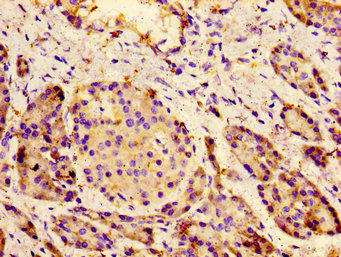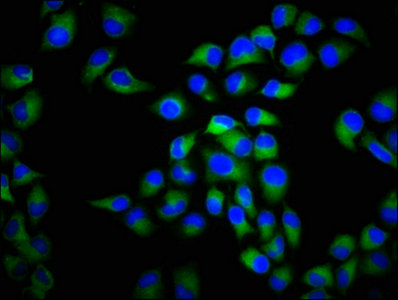
Immunohistochemistry of paraffin-embedded human pancreatic tissue using CSB-PA615724LA01HU at dilution of 1:100
CACNA1C Antibody

CSB-PA615724LA01HU
ApplicationsImmunoFluorescence, ELISA, ImmunoHistoChemistry
Product group Antibodies
ReactivityHuman
TargetCACNA1C
Overview
- SupplierCusabio
- Product NameCACNA1C Antibody
- Delivery Days Customer20
- ApplicationsImmunoFluorescence, ELISA, ImmunoHistoChemistry
- CertificationResearch Use Only
- ClonalityPolyclonal
- ConjugateUnconjugated
- Gene ID775
- Target nameCACNA1C
- Target descriptioncalcium voltage-gated channel subunit alpha1 C
- Target synonymsCACH2; CACN2; CACNL1A1; calcium channel, cardic dihydropyridine-sensitive, alpha-1 subunit; calcium channel, voltage-dependent, L type, alpha 1C subunit; CaV1.2; CCHL1A1; DHPR, alpha-1 subunit; LQT8; TS; TS. LQT8; voltage-dependent L-type Ca2+ channel alpha 1 subunit; voltage-dependent L-type calcium channel subunit alpha-1C; voltage-gated L-type calcium channel Cav1.2 alpha 1 subunit, splice variant 10*
- HostRabbit
- IsotypeIgG
- Protein IDQ13936
- Protein NameVoltage-dependent L-type calcium channel subunit alpha-1C
- Scientific DescriptionVoltage-sensitive calcium channels (VSCC) mediate the entry of calcium ions into excitable cells and are also involved in a variety of calcium-dependent processes, including muscle contraction, hormone or neurotransmitter release, gene expression, cell motility, cell division and cell death. The isoform alpha-1C gives rise to L-type calcium currents. Long-lasting (L-type) calcium channels belong to the \\\high-voltage activated\\\ (HVA) group. They are blocked by dihydropyridines (DHP), phenylalkylamines, benzothiazepines, and by omega-agatoxin-IIIA (omega-Aga-IIIA). They are however insensitive to omega-conotoxin-GVIA (omega-CTx-GVIA) and omega-agatoxin-IVA (omega-Aga-IVA). Calcium channels containing the alpha-1C subunit play an important role in excitation-contraction coupling in the heart. The various isoforms display marked differences in the sensitivity to DHP compounds. Binding of calmodulin or CABP1 at the same regulatory sites results in an opposit effects on the channel function.
- ReactivityHuman
- Storage Instruction-20°C or -80°C
- UNSPSC12352203

